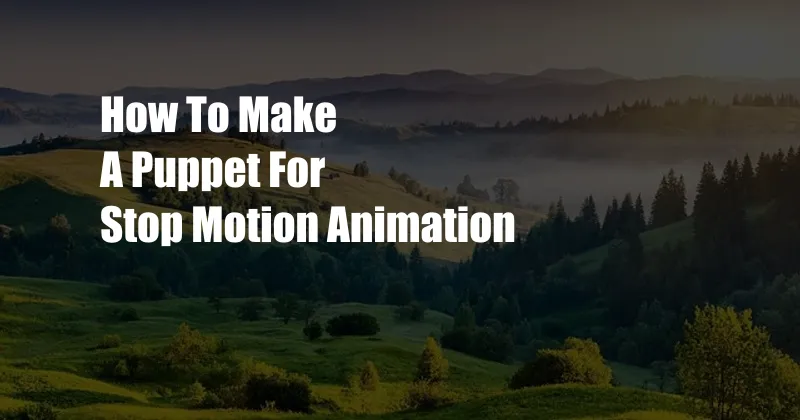
How to Embark on the Enchanting Journey of Stop Motion Animation: Understanding the Art of Puppetry
From the captivating world of Wes Anderson to the whimsical realms of Tim Burton, stop motion animation has enthralled audiences for decades. This intricate art form breathes life into inanimate objects, transforming them into captivating characters that dance across the screen.
If you’ve ever been captivated by the magic of stop motion, you may have wondered about the secrets behind these animated marvels. One key element is the puppet, a tangible representation that embodies the character’s personality and movements. In this comprehensive guide, we’ll delve into the enchanting world of puppetry, empowering you to craft your own creations for the captivating art of stop motion animation.
The Art of Puppetry: A Historical Panorama
Puppetry has roots as ancient as human civilization itself, dating back to ancient Egypt and Asia. Shadow puppets cast intricate silhouettes on cave walls, while marionettes danced with grace in royal courts. Over the centuries, puppetry evolved into a vibrant theatrical tradition, captivating audiences with its enchanting storytelling and imaginative possibilities.
Understanding the Puppet: A Blueprint of Design and Creation
The puppet, the central protagonist of stop motion animation, serves as an extension of the animator’s vision. Its design and construction are crucial in imbuing the character with personality and movement. Puppets can be crafted from diverse materials such as wood, fabric, clay, or even recycled objects, each lending its unique qualities to the final creation.
The type of puppet often depends on its intended purpose. Marionettes, controlled by strings attached to a crossbar, offer precise movements and intricate gestures. Rod puppets, manipulated by rods attached to their joints, provide greater flexibility and fluidity. Shadow puppets, silhouettes cast by a light source, create a magical ethereal effect.
Crafting the Puppet: A Step-by-Step Journey
Embarking on the journey of puppet creation requires meticulous planning and skillful execution. Here’s a step-by-step guide to crafting your own puppet for stop motion animation:
- Conceptualization: Envision the character’s personality, appearance, and purpose.
- Design: Sketch the puppet’s design, considering its proportions, shapes, and materials.
- Material Selection: Choose materials that align with the puppet’s design and intended movements.
- Construction: Assemble the puppet’s body, incorporating joints and mechanisms for articulation.
- Finishing: Add details such as facial features, clothing, and accessories to bring the character to life.
Advanced Techniques: Unlocking the Boundaries of Puppetry
Mastering the basics of puppetry opens the door to experimenting with advanced techniques. Stop motion animators often employ specialized methods to enhance the realism and expressiveness of their puppets.
- Character Rigging: Advanced puppet design involves rigging, using armatures or internal mechanisms, to achieve complex movements and expressions.
- Facial Animation: Animators can employ various techniques, such as mouth plates or silicone puppets, to create nuanced facial performances.
- Replacement Animation: Replacing entire puppet parts, such as limbs or heads, enables seamless transitions and dynamic movements.
Tips and Expert Advice: Mastering the Craft of Puppetry
Seasoned stop motion animators offer invaluable tips to elevate your puppet-making and animation skills:
- Experiment with Materials: Explore different materials to find the best fit for your puppet’s design and movements.
- Study Movement: Observe real-life movements to emulate realistic motions in your puppets.
- Practice Regularly: Consistent practice will refine your puppet manipulation skills and enhance your storytelling abilities.
Remember, the journey of stop motion animation is an iterative process. Experimentation, patience, and a passion for storytelling are essential ingredients in creating captivating puppets and bringing them to life on the screen.
FAQs: Illuminating the Path of Puppetry
What are the essential materials for puppet-making?
Common materials include wood, fabric, clay, foam, and recycled objects.
What puppet type is best for stop motion animation?
The choice depends on the character’s design and desired movements. Marionettes offer precision, rod puppets provide flexibility, and shadow puppets create an ethereal effect.
How do I make my puppets move smoothly?
Practice manipulating the puppet’s joints and experimenting with different techniques. Consider using armatures or rigging for advanced movement control.
Conclusion: Embracing the Magic of Stop Motion Puppetry
Puppetry, an ancient art form, has evolved into an indispensable tool in the captivating world of stop motion animation. Crafting your own puppets empowers you to breathe life into characters, telling unique stories, and sharing your imagination with audiences.
Are you ready to embark on the enchanting journey of stop motion puppetry? Share your creations, ask questions, and inspire fellow animators in the comments below. Together, let’s unravel the limitless possibilities of this captivating art form.